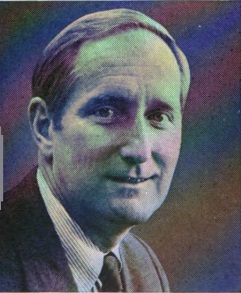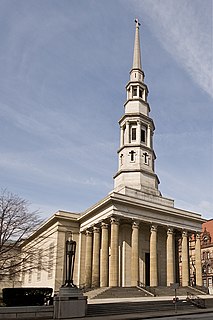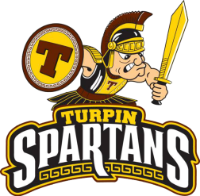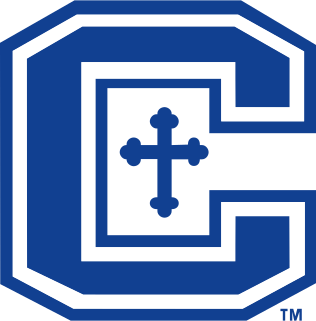
William John Keating was an American lawyer, businessman and politician of the Republican party. He served in the United States House of Representatives from 1971 to 1974.

Saint Ignatius High School is a private Roman Catholic, Jesuit high school under the Diocese of Cleveland, for young men, located in the Ohio City neighborhood of Cleveland, Ohio.

The Archdiocese of Cincinnati is a Latin Church ecclesiastical jurisdiction or archdiocese that covers the southwest region of the U.S. state of Ohio, including the greater Cincinnati and Dayton metropolitan areas. The Archbishop of Cincinnati is Dennis Marion Schnurr. The Archdiocese of Cincinnati is the metropolitan see of its province, with five suffragan dioceses.
Elder High School is a Catholic all-male, college-preparatory high school in the Price Hill neighborhood of Cincinnati, Ohio. The high school has been in existence for nearly 100 years, and is a diocesan high school within the Archdiocese of Cincinnati.

Saint Xavier High School is a private, college-preparatory high school just outside the Cincinnati city limits, in the Finneytown neighborhood of Springfield Township, Hamilton County, Ohio, United States. The independent, non-diocesan school is operated by the Midwest Province of the Society of Jesus as one of four all-male Catholic high schools in the Archdiocese of Cincinnati. Aside from colleges and universities, St. Xavier is the second-largest private school in Ohio and one of the 100 largest schools in the state, with 1,514 enrolled students as of the 2018–19 school year. It is the second-largest of the 35 all-male high schools run by the Society of Jesus in the United States.

Jackson High School is a public high school located in Jackson Township, Ohio, United States, near Massillon. Part of the Jackson Local School District, it serves grades 9 through 12. The school's colors are purple and gold and the athletic teams are known as the Polar Bears.

Moeller High School, known as Moeller, is a private, all-male, college-preparatory high school in the suburbs of Cincinnati, in Hamilton County, Ohio. It is currently one of four all-male Catholic high schools in the Cincinnati area.

The Ohio High School Athletic Association (OHSAA) is the governing body of athletic programs for junior and senior high schools in the state of Ohio. The OHSAA governs eligibility of student athletes, resolves disputes, organizes levels of competition by divisional separation of schools according to attendance population, and conducts state championship competitions in all the OHSAA-sanctioned sports.

Purcell Marian High School is a parochial high school in the East Walnut Hills neighborhood of Cincinnati, Ohio, United States, based in the Marianist tradition. It is located in the DeSales Corner business district, along Madison Road.

La Salle High School is a Catholic, all-male, archdiocesan high school in Cincinnati, Ohio. The school was opened September 6, 1960, and was named in honor of Jean-Baptiste de La Salle, a French priest, and educational reformer. The school was officially dedicated on May 14, 1961. It was founded by the Institute of the Brothers of the Christian Schools.

Turpin High School is a public high school in Cincinnati, Ohio, United States that serves grades nine through twelve. The school is part of the Forest Hills Local School District and serves the suburb of Anderson Township; admission is based primarily on the location of a student's home. Turpin is accredited by the Ohio Department of Education and the North Central Association of Secondary Schools and Colleges. Turpin is a member of the Ohio Association of College Admissions Counselors and of the National Association of College Admissions Counselors.
William Mason High School, also known as Mason High School, is a four-year public high school located in the Mason City Schools district in Mason, Ohio, a suburb of Cincinnati, Ohio.
Woodward Career Technical High School is a public high school located in the Bond Hill neighborhood of Cincinnati, Ohio, United States. It is part of the Cincinnati Public School District. It was founded as one of the first public schools in the United States in 1831.

Sycamore High School (SHS) is a four-year public high school in the northeast suburbs of Cincinnati, Ohio. It is the only high school in the Sycamore Community School District. Sycamore High School offers more than 223 courses including six global languages, more than 20 AP course offerings, and post-AP level classes.

Fairfield High School is a public high school in Fairfield, Ohio, United States. It is the only high school in the Fairfield City School District, and serves grades 10–12. The Fairfield City School district serves students in the city of Fairfield and Fairfield Township.

Covington Catholic High School is a private Catholic high school for boys in Park Hills, Kentucky, United States. It was founded in 1925 by Bishop Francis William Howard and Brother George Sauer, and is part of the Roman Catholic Diocese of Covington. The school is the only boys' high school in northern Kentucky and one of five in the Cincinnati area. The girls' Notre Dame Academy is located across the street.

Wheelersburg High School (WHS) is a public high school in Wheelersburg, Ohio, United States. It is the only high school in the Wheelersburg Local School District, which is located in Porter Township along the northern bank of the Ohio River in Southern Ohio. Wheelersburg's mascot is the Pirates and their school colors are orange and black.

The Clay Local School District (CLSD) is located four miles (6.4 km) north of the Portsmouth, Ohio, city limits on U.S. Route 23 in Clay Township in Scioto County—which is 85 miles (137 km) south of Columbus, Ohio; 50 miles (80 km) west of Huntington, West Virginia; and 100 miles (160 km) east of Cincinnati, Ohio. Clay is a rural Ohio public school district serving 700 students in grades pre-K through 12 in Southern Ohio. With the creation of a high school for the district in 1940, students for the first time were able to graduate from a Clay Local School District building.
The 1929 St. Xavier Musketeers football team was an American football team that represented St. Xavier College as a member of the Ohio Athletic Conference (OAC) during the 1929 college football season. In its tenth season under head coach Joseph A. Meyer, the team compiled a 6–4 record and outscored all opponents by a total of 104 to 92.















